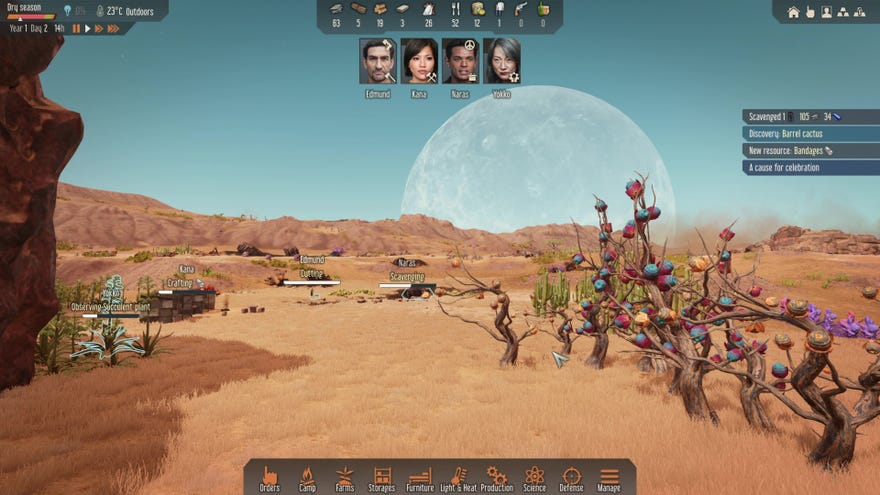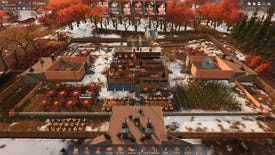Stranded: Alien Dawn is on a mission to disrupt what we know about survival sims, and it's working
We chat to the Surviving Mars devs about their latest otherworldly base builder
"Do not be afraid to die." That's the advice of Haemimont Games' CEO Bisser Dyankov when it comes to playing their new open world survival sim Stranded: Alien Dawn. Having launched into early access in mid-October, the latest game from the Surviving Mars devs has just recently doubled in size to include a brand-new desert biome in its Dunes And Moons update, adding harsh temperature extremes to deal with, new alien lifeforms to observe, and, you know, just the odd Chaos Moon to endure while you're at it.
The world of Desertum is certainly a marked change from Stranded's initial mountainous forest planet, Sobrius, but after a few weeks of trying (and inevitably failing) to stay alive in them, I do feel like I've settled on a couple of vital dos and don'ts now. For example, Do: invest in defences early on. Don't: eat that weird alien zebra camel until you know whether it's going to give you gut rot. The list goes on, and has only grown larger with the addition of Desertum, which was deliberately designed to "challenge players to plan better and not rely on their previous knowledge," Dyankov tells me. "Our aim here has been to find a balance between the familiar and unfamiliar within the Desertum Biome, to ensure it's a challenging place to build your base, but is also enjoyable." I'll try to remember that the next time horned dinosaurs are gnawing my survivors' legs off.
In all seriousness, though, I've been enjoying eking out a rudimentary existence in Stranded: Alien Dawn. After crash landing on your biome of choice, your band of four survivors will need to immediately set about creating a makeshift base to protect them from the elements. You start small at first, constructing rickety shacks salvaged from materials found in your crashed ship, but whereas on Sobrius you might set about harvesting trees and bushes for your all-important campfire, Desertum isn't nearly so plentiful when it comes to these kinds of construction materials. And it gets proper cold at night out on the sands, which means building and maintaining your campfire is much more important than it was back on Sobrius. Tricky, when there's not a lot of wood to feed it with.
At first, that might seem like a small and subtle tweak on the strategic rhythms you'll need to deploy playing Stranded, but when you also chuck in potential dust storms and those aforementioned temperature drops, which in turn hasten the decay of any resources left out in the open, it's a gradual snowballing of different systems that make Desertum feel like a substantially different challenge to your time spent on Sobrius.
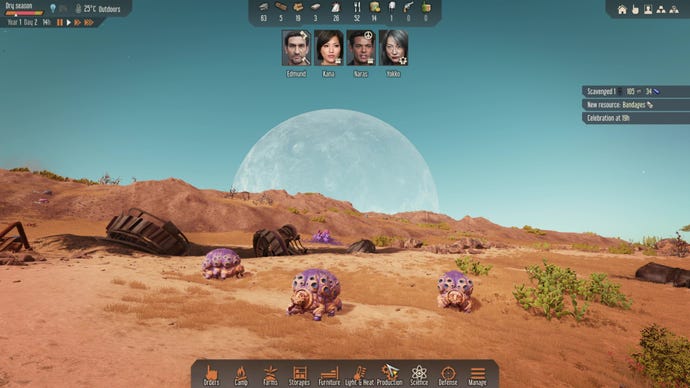
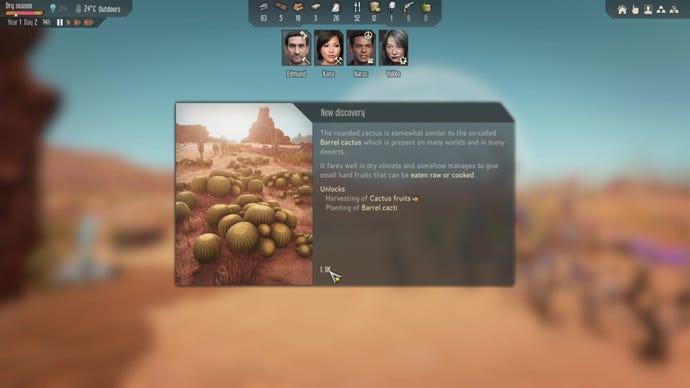
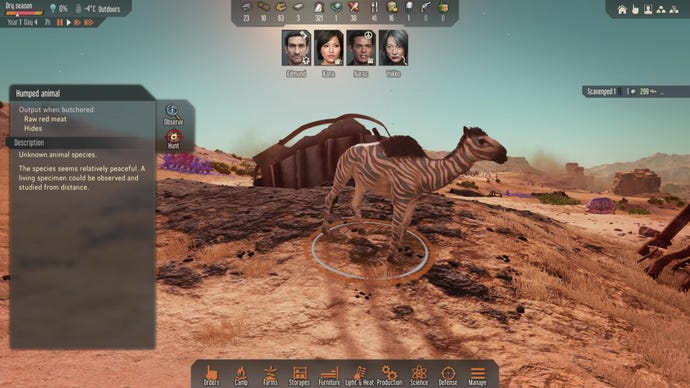
They do, at least, share one common trait: unlike your pals in Surviving Mars, Stranded's survivors can breathe the air unaided, making it a touch easier to get going with a run once you've dusted yourselves off from your unexpected crash landing. I was curious, though. By creating Earth-like atmospheres for their alien planets, did this limit the types of biomes Haemimont were able to create in order to fit the fiction? When I put the question to Dyankov, he conceded there were elements of Stranded's worlds that "certainly could be considered Earth-like", as James did when he first saw it at Gamescom ahead of its early access launch, but for him and the development team, it's the wider survival challenges players face that help make them feel hostile and truly alien.
"From the very start, we wanted to place the focus of the game on observation, preparation and finding a way to tackle challenges," he says. "The alien world our survivors encounter needs to be discovered first - strange plants have unknown uses, animals display unpredictable behaviour. The survivors will have to gather knowledge for their new home and use this to overcome adversity. Ultimately, we’re striving to strike a balance between an unknown environment and elements that are recognisable to the players so they can build up a credible fiction in their minds as they carve out their survivors’ stories."

Indeed, observing a planet's flora and fauna is key to making the most of the resources in front of you - hence my number one Don't rule of not eating Desertum's zebra camels ( also known as Dromadda once you've spent enough time studying them) until you know they are, in fact, safe to chow down on. Sending your survivors out to observe certain types of animals will reveal different traits and ways to approach them (shoot, don't spear the poison-spewing bugs, for example), while turning your attention to plants and cacti will yield crucial farming know-how, letting you grow more of these precious plants to feed both your campfire and your hungry bellies. You can still butcher animals and cut down plants to gain materials without observing them first, of course, but putting in the effort to learn about your surroundings will almost always reveal new hidden layers to it that will prove invaluable to keeping your survivors alive.
Speaking of those zebra camels, I also chatted with Dyankov about the creation process for their alien wildlife as well, and whether the familiar, Earth-like conditions of their environment also had an impact on the way they were designed. As it turns out, Haemimont deliberately leaned into making their animals more lifelike in this case, in order to help players predict how they might behave.
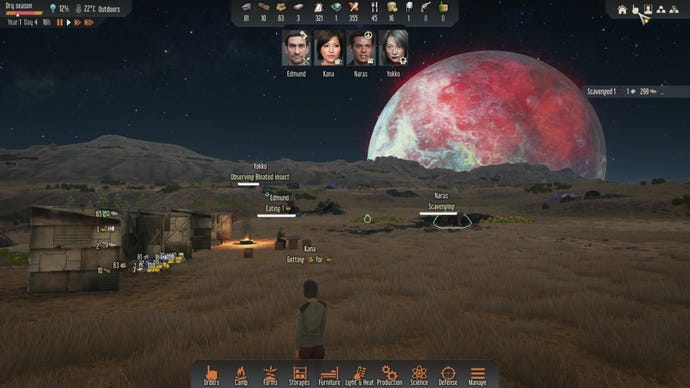
"While the alien wildlife gives us more freedom in the species design, it still draws inspiration from the nature on Earth for the very same reason - recognisability," says Dyankov. "This gave us the opportunity to create the peaceful creatures, hostile insectoids, birds of prey, and so on. Inspiration from the Earth’s fauna was critical, so we could ensure their behaviours are intelligible to the players. What you will see in the game is our idea of beautiful, unfamiliar, and yet somewhat recognisable alien wildlife."
Not its giant ant-like scorpion Shirkers, though, Dyankov jests. "They were not meant to be very beautiful!"
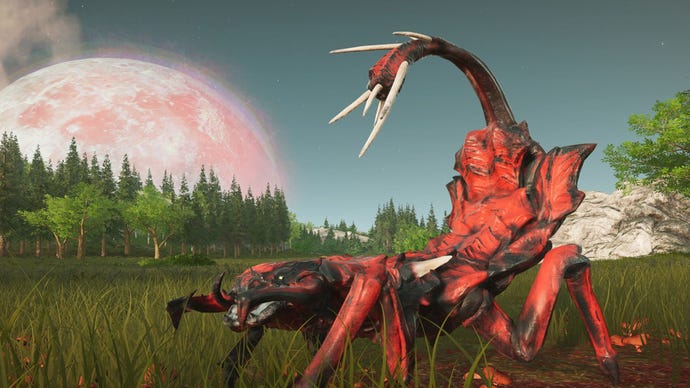
It's not just Stranded's animals that draw on their real-life counterparts. The technology you craft in Alien Dawn also has a very distinct, contemporary look to it. You might start off building shelters out of scrap metal from your ship, for example, but soon you'll be building log cabins with stoves, air con units, generators, electricity pylons and more, making your base look more like a mountain spa retreat than an sci-fi basecamp.
Dyankov tells me "the temptation to go more fantastical is always there," but ultimately the team opted once again for something a little more familiar. "What we experienced in the discovery period of development is that, to make a certain system deep, believable, and intuitive, you ultimately rely on the player’s real-world knowledge," he says.
Take the game's use of electricity, for example. "We knew we would have electricity and it will affect your base at later stages of development – from automated defences, to refrigerators and heaters, and so on," Dyankov explains. "Then, this system will need enough variety in its elements to be deep enough to provide both gameplay challenge and fun. Having, for example, an alien crystal that can power everything would not provide much of a puzzle to solve. Same with the building materials. Recognisability helps to reduce complexity and create a smoother experience. We can also assume that the survivors are coming from our own, familiar world, and will use their own knowledge in their attempts to make it another day."
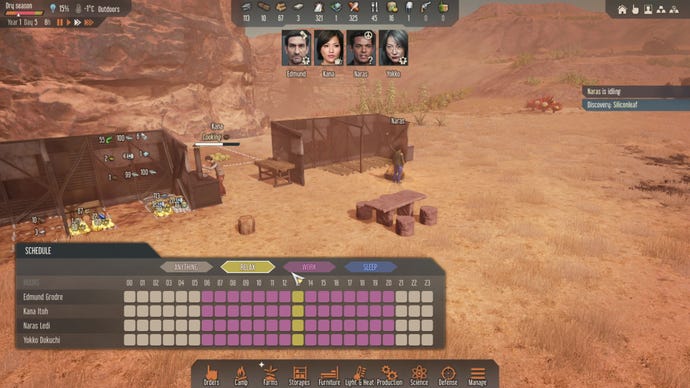
Despite all this, though, Haemimont's still been "very surprised" by what players have ended up creating with their bases. "We've been really impressed by their many different approaches - while some enjoy building big bases that provide all sorts of comforts for the group of survivors, others try to explore the unknown environment and engage into conflict with the aggressive insectoids and their nests," says Dyankov. "We've seen that some even managed to survive over 20 (in-game) years in the alien environment, while others made buildings and defences that surpassed our own experience in constructing cool looking bases."
Admittedly, he thinks "there's a natural limitation to the many bases approach", since there are only so many survivors you can have in your group and that players would be wise to keep them close together, but he also added that this wide variety of playstyles has been instrumental in "helping [to] inform our ongoing development during early access."
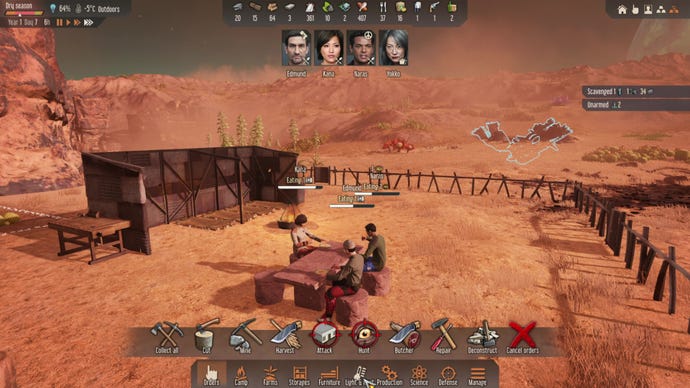
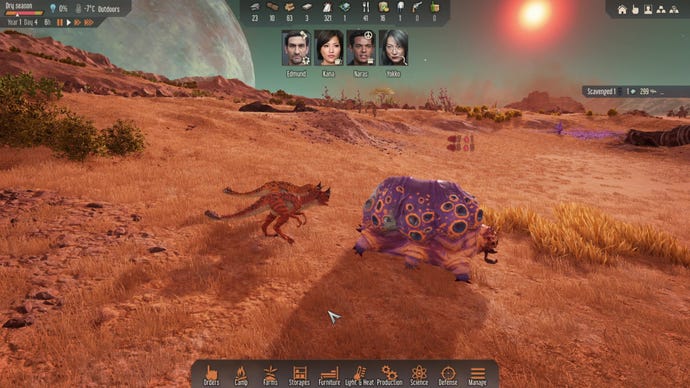
Of course, the challenges posed by Desertum covers the Dunes part of Stranded: Alien Dawn's latest update, but if players really want to make things difficult for their survivors, there's also the aforementioned Moons to throw into the mix as well. Like biomes, players can now pick from a variety of different moons to add new parameters to the game before they begin, and Dyankov tells me that these effects once again take inspiration from real-world stories, this time based on Greek mythology.
"Specifically, how the gods and goddesses live in the skies, and have a profound effect on the fates of the mortals, but not complete control over it," he says. "Through actions, determination, and power of the will, mortals can overcome any challenge thrown at them. This is the reason why the Moons in Stranded: Alien Dawn bear names from the Greek mythology. We wanted to have an overarching embodiment, or persona, of the environment that the player is facing.
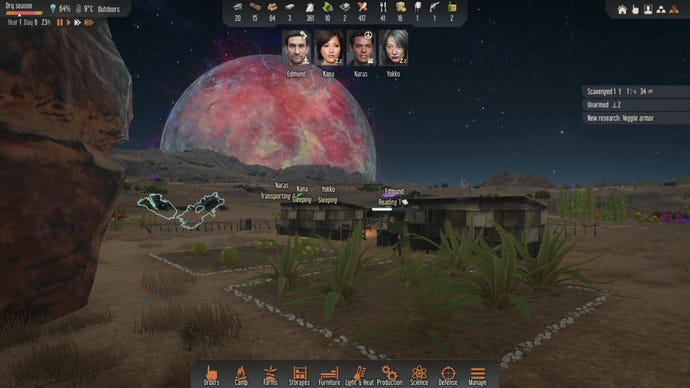
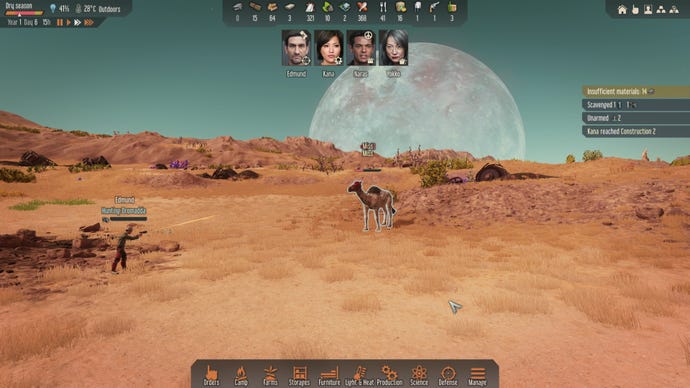

"The effect of the Moons is profound – Jason will give the player more time to prepare for challenges, but then the challenges themselves will become stronger and stronger as the game progresses; Nyx will pose threats during the night; and Chaos is not for the faint-hearted, it will seize every opportunity to surprise the player when they least suspects. The pace with this particular moon might be challenging even for the most experienced players."
I'm too chicken to even attempt its very Breath Of The Wild-sounding Chaos Moon (mostly because I'm too scared of being instantly nuked by its aggressive Shirkers), but hey, at least it makes for some stunning vistas along the way. Even if the rest of Stranded: Alien Dawn is grounded in the familiar, its enormous, screen-hogging moons do a tremendous job of reminding you that, yep, definitely not in Kansas anymore, no sir.
Then again, I should probably just heed Dyankov's advice and jump straight in, dying be damned. "[Death] is all part of refining your strategy," he says, noting that the game's moons, biomes and wide array of pre-defined survivors are all there to give you a different experience every time you play. Indeed, considering Stranded: Alien Dawn's only halfway through its six-month early access period at time of writing, I've been consistently impressed by how different each of my playthroughs have been, making it one of the few survival games I've played that's actually stuck with me. Everything I've seen so far makes me excited for where Stranded: Alien Dawn goes next, and Dyankov tells me Haemimont "have plans on how to make the lives of our survivors even more eventful" as it heads towards its final release. Now if you'll excuse me, I've got a Chaos Moon to go and howl at.
